Hyundai Terracan 2007 Owner's Manual
Manufacturer: HYUNDAI, Model Year: 2007, Model line: Terracan, Model: Hyundai Terracan 2007Pages: 291, PDF Size: 12.79 MB
Page 241 of 291
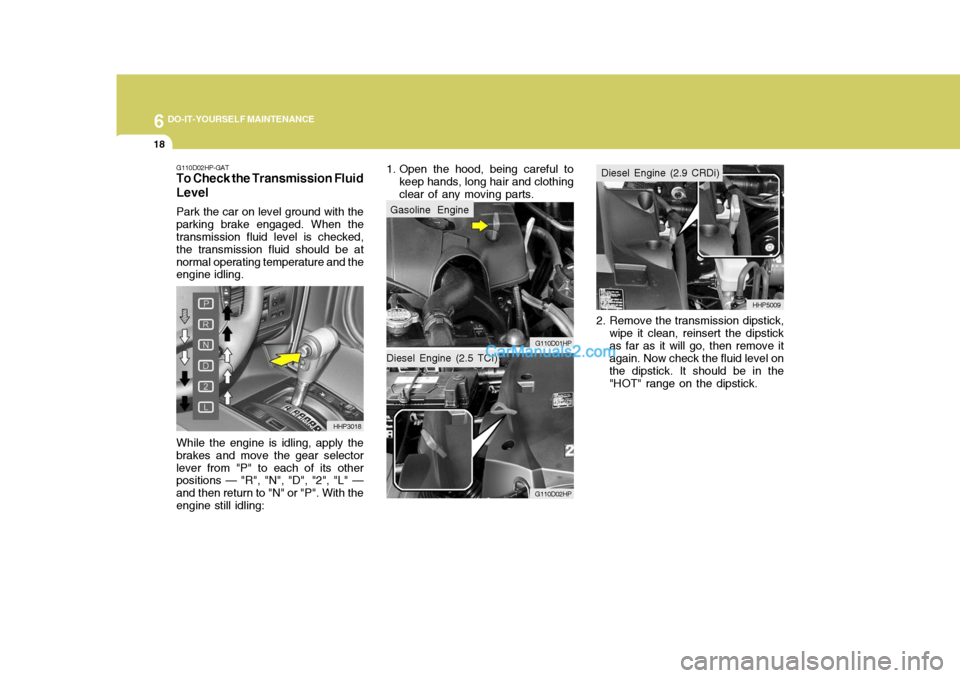
6 DO-IT-YOURSELF MAINTENANCE
18
G110D02HP-GAT
To Check the Transmission Fluid Level
Park the car on level ground with the parking brake engaged. When the transmission fluid level is checked, the transmission fluid should be atnormal operating temperature and the engine idling. While the engine is idling, apply the brakes and move the gear selectorlever from "P" to each of its other positions — "R", "N", "D", "2", "L" — and then return to "N" or "P". With theengine still idling: HHP30181. Open the hood, being careful to
keep hands, long hair and clothingclear of any moving parts.
2. Remove the transmission dipstick,wipe it clean, reinsert the dipstickas far as it will go, then remove it again. Now check the fluid level on the dipstick. It should be in the"HOT" range on the dipstick. HHP5009
G110D01HP
G110D02HP
Diesel Engine (2.5 TCI) Gasoline Engine
Diesel Engine (2.9 CRDi)
Page 242 of 291
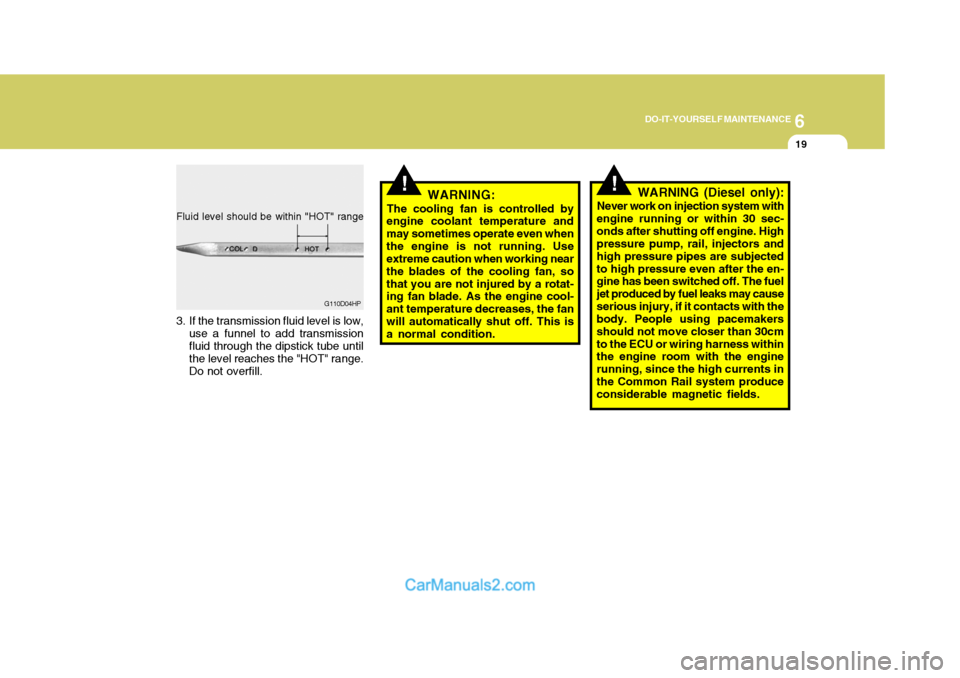
6
DO-IT-YOURSELF MAINTENANCE
19
Fluid level should be within "HOT" range
3. If the transmission fluid level is low, use a funnel to add transmission fluid through the dipstick tube until the level reaches the "HOT" range. Do not overfill. G110D04HP
!!WARNING:
The cooling fan is controlled by
engine coolant temperature and may sometimes operate even whenthe engine is not running. Use extreme caution when working near the blades of the cooling fan, sothat you are not injured by a rotat- ing fan blade. As the engine cool- ant temperature decreases, the fanwill automatically shut off. This is a normal condition. WARNING (Diesel only):
Never work on injection system with
engine running or within 30 sec- onds after shutting off engine. High pressure pump, rail, injectors and high pressure pipes are subjectedto high pressure even after the en- gine has been switched off. The fuel jet produced by fuel leaks may causeserious injury, if it contacts with the body. People using pacemakers should not move closer than 30cmto the ECU or wiring harness within the engine room with the engine running, since the high currents inthe Common Rail system produce considerable magnetic fields.
Page 243 of 291
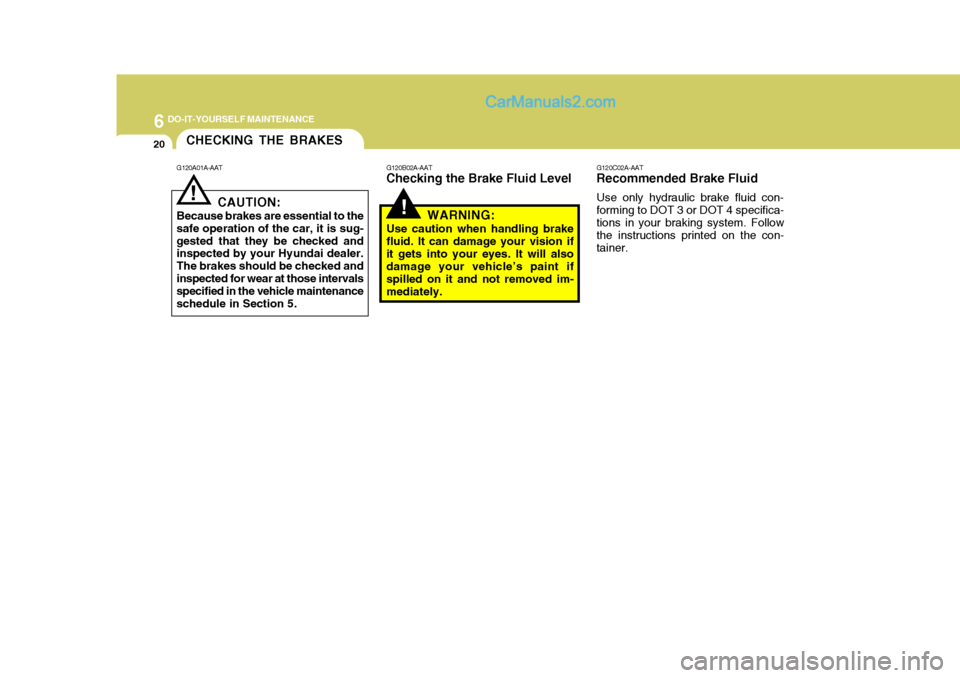
6 DO-IT-YOURSELF MAINTENANCE
20CHECKING THE BRAKES
!
!
G120A01A-AAT
CAUTION:
Because brakes are essential to the
safe operation of the car, it is sug- gested that they be checked and inspected by your Hyundai dealer. The brakes should be checked andinspected for wear at those intervals specified in the vehicle maintenance schedule in Section 5. G120B02A-AAT
Checking the Brake Fluid Level
WARNING:
Use caution when handling brakefluid. It can damage your vision ifit gets into your eyes. It will also damage your vehicle’s paint if spilled on it and not removed im-mediately. G120C02A-AAT
Recommended Brake Fluid
Use only hydraulic brake fluid con-forming to DOT 3 or DOT 4 specifica- tions in your braking system. Follow the instructions printed on the con-tainer.
Page 244 of 291
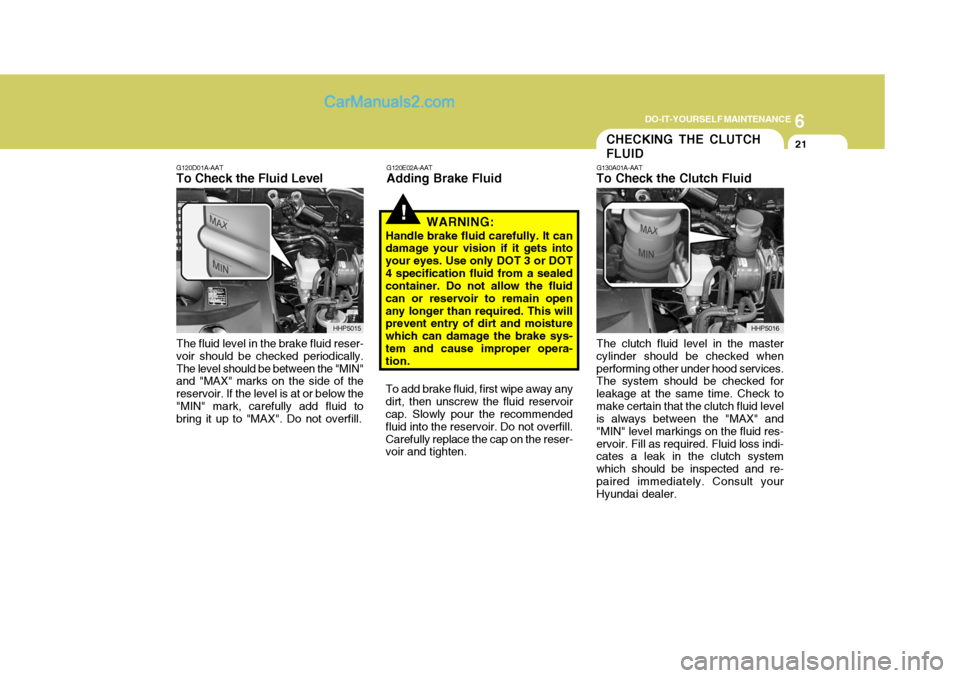
6
DO-IT-YOURSELF MAINTENANCE
21
!
G120E02A-AAT
Adding Brake Fluid
WARNING:
Handle brake fluid carefully. It can damage your vision if it gets into your eyes. Use only DOT 3 or DOT4 specification fluid from a sealed container. Do not allow the fluid can or reservoir to remain openany longer than required. This will prevent entry of dirt and moisture which can damage the brake sys-tem and cause improper opera- tion.
To add brake fluid, first wipe away any dirt, then unscrew the fluid reservoir cap. Slowly pour the recommended fluid into the reservoir. Do not overfill.Carefully replace the cap on the reser- voir and tighten.
CHECKING THE CLUTCH FLUID
G130A01A-AAT
To Check the Clutch Fluid The clutch fluid level in the master cylinder should be checked whenperforming other under hood services. The system should be checked for leakage at the same time. Check tomake certain that the clutch fluid level is always between the "MAX" and "MIN" level markings on the fluid res-ervoir. Fill as required. Fluid loss indi- cates a leak in the clutch system which should be inspected and re-paired immediately. Consult your Hyundai dealer. HHP5016
G120D01A-AAT
To Check the Fluid Level
The fluid level in the brake fluid reser-
voir should be checked periodically. The level should be between the "MIN" and "MAX" marks on the side of the reservoir. If the level is at or below the"MIN" mark, carefully add fluid to bring it up to "MAX". Do not overfill. HHP5015
Page 245 of 291
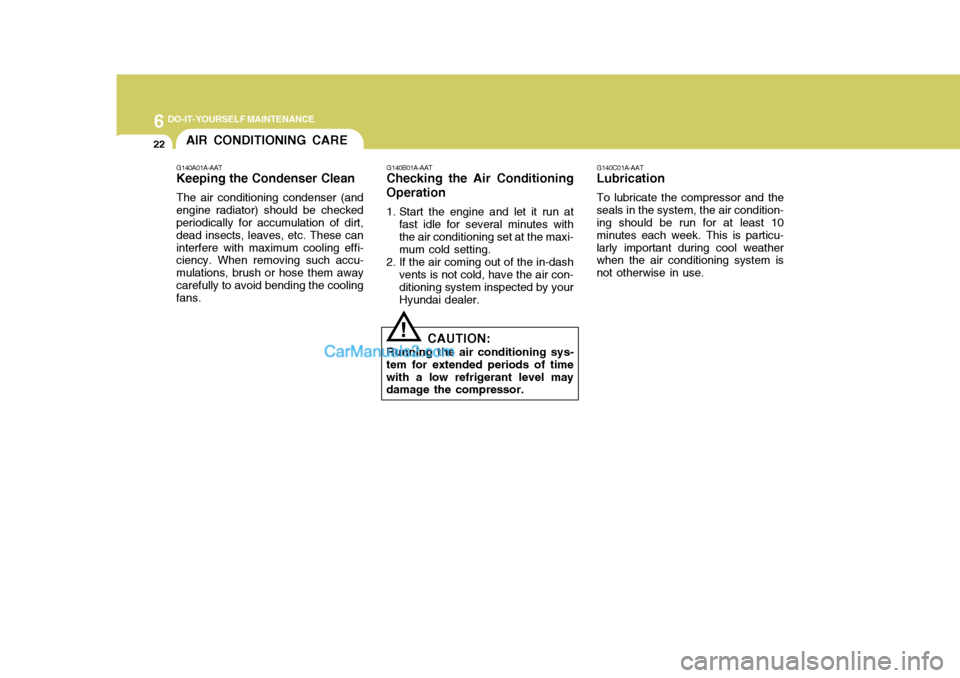
6 DO-IT-YOURSELF MAINTENANCE
22
G140B01A-AAT
Checking the Air Conditioning Operation
1. Start the engine and let it run at
fast idle for several minutes with the air conditioning set at the maxi- mum cold setting.
2. If the air coming out of the in-dash vents is not cold, have the air con-ditioning system inspected by yourHyundai dealer.
CAUTION:
Running the air conditioning sys-
tem for extended periods of timewith a low refrigerant level may damage the compressor.
! G140C01A-AAT
Lubrication
To lubricate the compressor and the
seals in the system, the air condition- ing should be run for at least 10 minutes each week. This is particu-larly important during cool weather when the air conditioning system is not otherwise in use.
AIR CONDITIONING CARE
G140A01A-AAT Keeping the Condenser Clean The air conditioning condenser (and engine radiator) should be checked periodically for accumulation of dirt, dead insects, leaves, etc. These caninterfere with maximum cooling effi- ciency. When removing such accu- mulations, brush or hose them awaycarefully to avoid bending the cooling fans.
Page 246 of 291
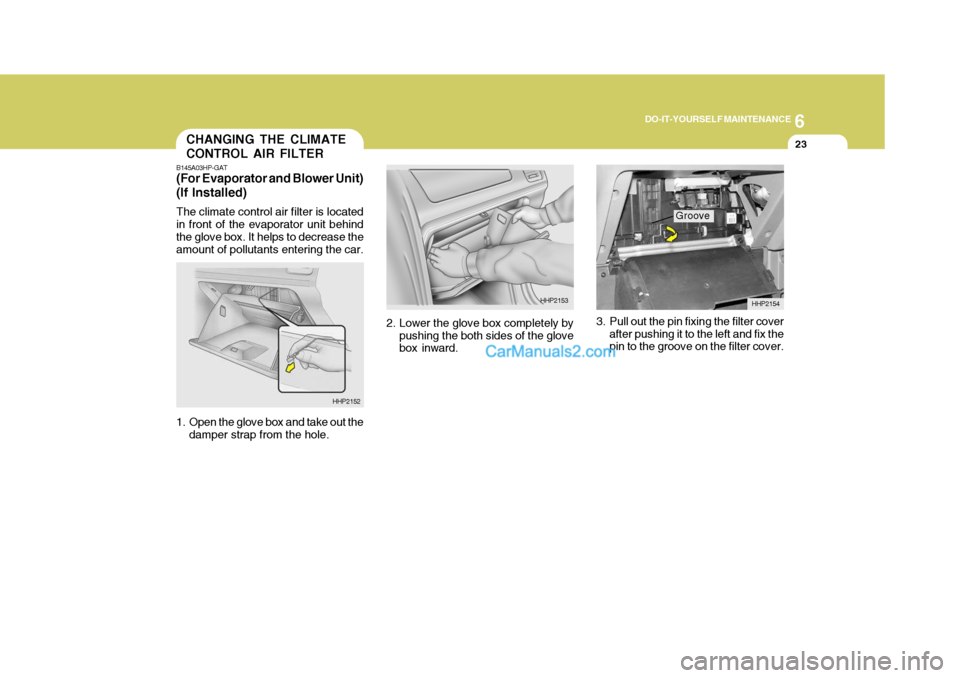
6
DO-IT-YOURSELF MAINTENANCE
23
3. Pull out the pin fixing the filter cover
after pushing it to the left and fix the pin to the groove on the filter cover.
2. Lower the glove box completely by
pushing the both sides of the glovebox inward. HHP2153
HHP2154
Groove
CHANGING THE CLIMATE CONTROL AIR FILTER
B145A03HP-GAT
(For Evaporator and Blower Unit)(If Installed)
The climate control air filter is located
in front of the evaporator unit behind the glove box. It helps to decrease the amount of pollutants entering the car.
1. Open the glove box and take out the damper strap from the hole. HHP2152
Page 247 of 291
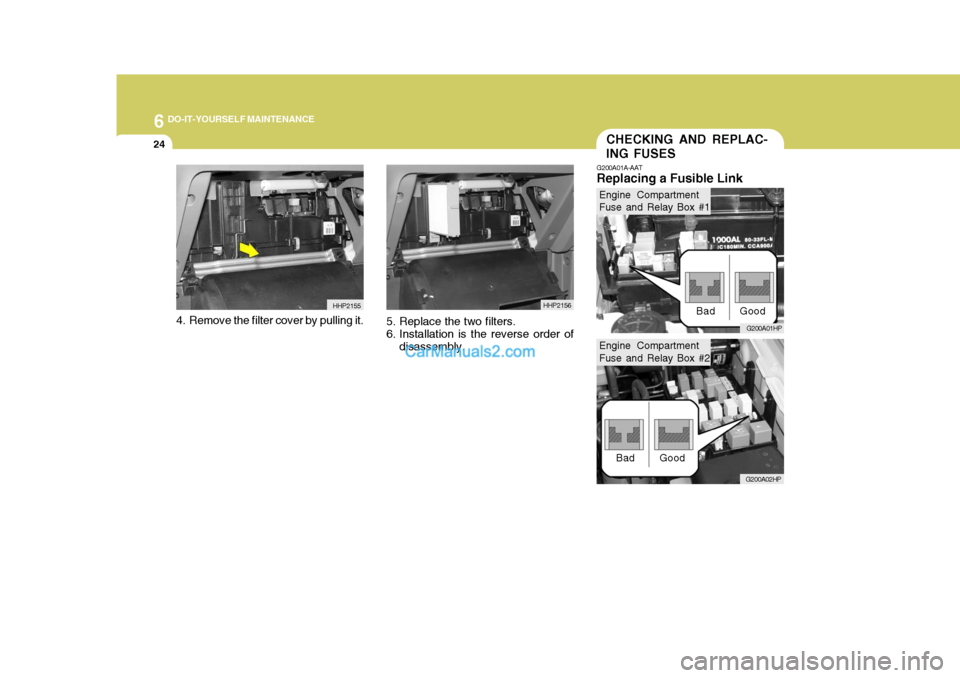
6 DO-IT-YOURSELF MAINTENANCE
24CHECKING AND REPLAC- ING FUSES
G200A01A-AAT
Replacing a Fusible Link
G200A01HP
G200A02HP
Bad Good Bad Good
Engine Compartment Fuse and Relay Box #1
Engine Compartment Fuse and Relay Box #2
5. Replace the two filters.
6. Installation is the reverse order of
disassembly. HHP21564. Remove the filter cover by pulling it.
HHP2155
Page 248 of 291
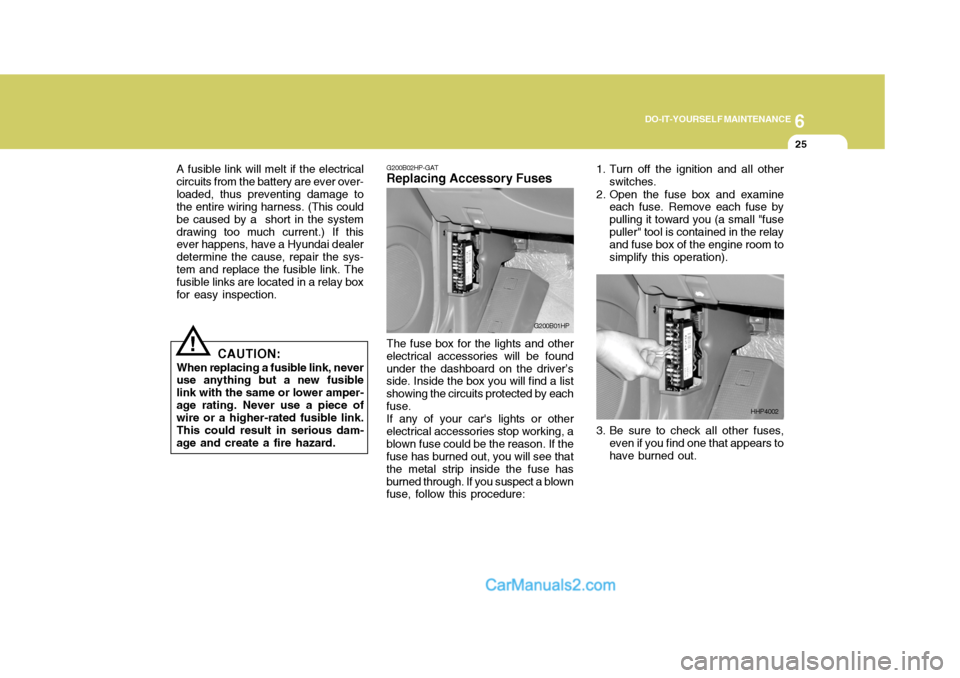
6
DO-IT-YOURSELF MAINTENANCE
25
G200B02HP-GAT
Replacing Accessory Fuses
The fuse box for the lights and other
electrical accessories will be found under the dashboard on the driver’s side. Inside the box you will find a list showing the circuits protected by eachfuse. If any of your car's lights or other
electrical accessories stop working, ablown fuse could be the reason. If the fuse has burned out, you will see that the metal strip inside the fuse hasburned through. If you suspect a blown fuse, follow this procedure: G200B01HP
!
A fusible link will melt if the electrical
circuits from the battery are ever over- loaded, thus preventing damage to the entire wiring harness. (This could be caused by a short in the systemdrawing too much current.) If this ever happens, have a Hyundai dealer determine the cause, repair the sys-tem and replace the fusible link. The fusible links are located in a relay box for easy inspection.
CAUTION:
When replacing a fusible link, never use anything but a new fusible link with the same or lower amper-age rating. Never use a piece of wire or a higher-rated fusible link. This could result in serious dam-age and create a fire hazard. 3. Be sure to check all other fuses,
even if you find one that appears tohave burned out.
1. Turn off the ignition and all other
switches.
2. Open the fuse box and examine each fuse. Remove each fuse bypulling it toward you (a small "fusepuller" tool is contained in the relay and fuse box of the engine room to simplify this operation).
HHP4002
Page 249 of 291
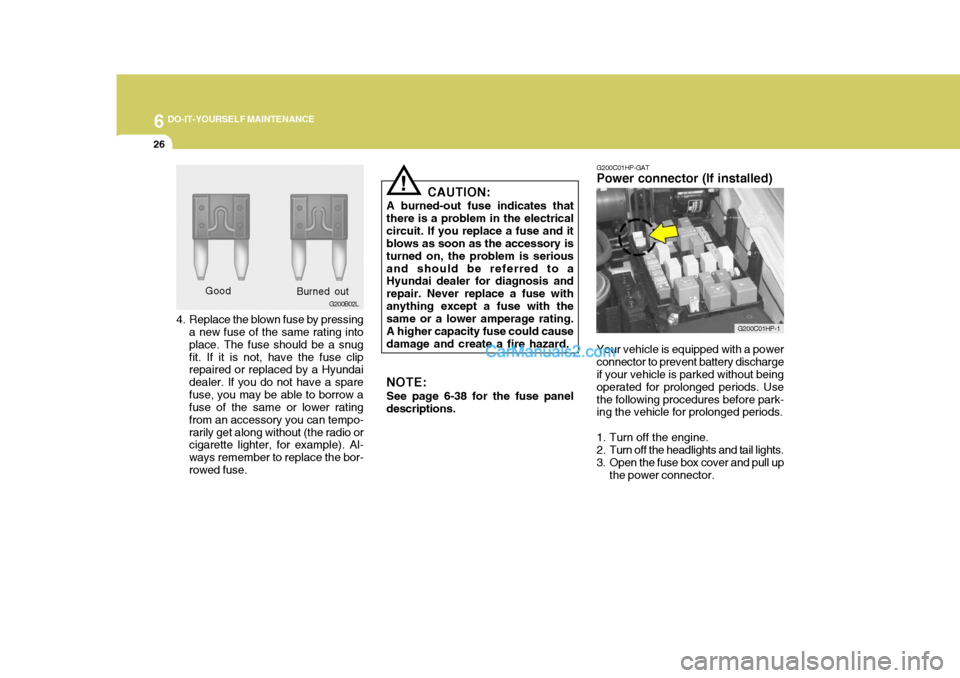
6 DO-IT-YOURSELF MAINTENANCE
26
4. Replace the blown fuse by pressing
a new fuse of the same rating into place. The fuse should be a snugfit. If it is not, have the fuse clip repaired or replaced by a Hyundai dealer. If you do not have a sparefuse, you may be able to borrow a fuse of the same or lower rating from an accessory you can tempo-rarily get along without (the radio or cigarette lighter, for example). Al- ways remember to replace the bor-rowed fuse. Good
G200B02L
Burned out CAUTION:
A burned-out fuse indicates thatthere is a problem in the electricalcircuit. If you replace a fuse and it blows as soon as the accessory is turned on, the problem is seriousand should be referred to a Hyundai dealer for diagnosis and repair. Never replace a fuse withanything except a fuse with the same or a lower amperage rating. A higher capacity fuse could causedamage and create a fire hazard. NOTE: See page 6-38 for the fuse panel descriptions.
! G200C01HP-GAT
Power connector (If installed)
Your vehicle is equipped with a power connector to prevent battery discharge if your vehicle is parked without being operated for prolonged periods. Usethe following procedures before park- ing the vehicle for prolonged periods.
1. Turn off the engine.
2. Turn off the headlights and tail lights.
3. Open the fuse box cover and pull up the power connector.
G200C01HP-1
Page 250 of 291
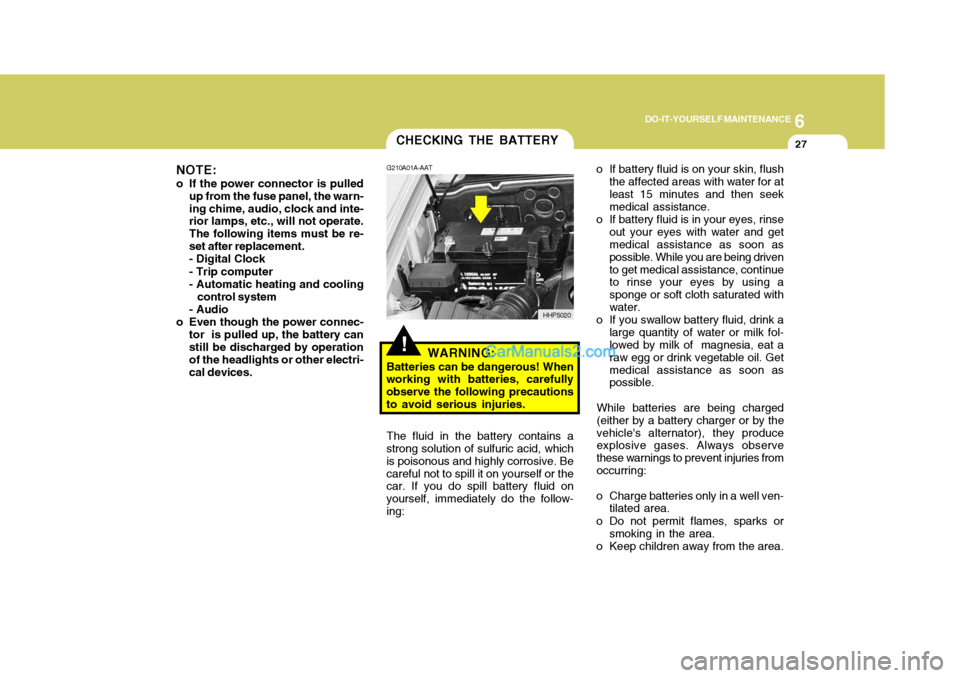
6
DO-IT-YOURSELF MAINTENANCE
27CHECKING THE BATTERY
!
G210A01A-AAT
WARNING:
Batteries can be dangerous! When
working with batteries, carefully observe the following precautionsto avoid serious injuries. o If battery fluid is on your skin, flush
the affected areas with water for atleast 15 minutes and then seek medical assistance.
o If battery fluid is in your eyes, rinse out your eyes with water and getmedical assistance as soon as possible. While you are being drivento get medical assistance, continue to rinse your eyes by using a sponge or soft cloth saturated withwater.
o If you swallow battery fluid, drink a large quantity of water or milk fol- lowed by milk of magnesia, eat a raw egg or drink vegetable oil. Getmedical assistance as soon as possible.
While batteries are being charged (either by a battery charger or by thevehicle's alternator), they produce explosive gases. Always observe these warnings to prevent injuries fromoccurring:
o Charge batteries only in a well ven- tilated area.
o Do not permit flames, sparks or smoking in the area.
o Keep children away from the area.
The fluid in the battery contains a
strong solution of sulfuric acid, whichis poisonous and highly corrosive. Becareful not to spill it on yourself or the car. If you do spill battery fluid on yourself, immediately do the follow-ing: HHP5020
NOTE:
o If the power connector is pulled up from the fuse panel, the warn-ing chime, audio, clock and inte- rior lamps, etc., will not operate. The following items must be re-set after replacement.- Digital Clock - Trip computer
- Automatic heating and cooling
control system
- Audio
o Even though the power connec- tor is pulled up, the battery can still be discharged by operation of the headlights or other electri-cal devices.